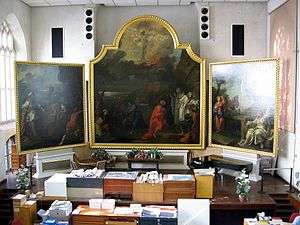Sealing the Tomb
Sealing the Tomb is a great altarpiece triptych by William Hogarth in the English city of Bristol. It was commissioned for St Mary Redcliffe in 1755. In the 19th century attempts were made to sell it, but it was given to the Bristol Fine Art Academy, which became the Royal West of England Academy. Its size made it difficult to display and it was rolled up and stored in the basement. In 1973 it was displayed in the ecclesiastical museum created in the war-damaged Church of St Nicholas. When the museum closed it was converted to offices; however the triptych remains in the building. It is on display to the public again after the church was re-consecrated in 2018.
| Sealing the Tomb | |
|---|---|
 | |
| Artist | William Hogarth |
| Year | 1755 |
| Type | triptych |
| Medium | Oil on canvas |
| Subject | Sealing the Tomb |
| Dimensions |
|
| Location | St Nicholas, Bristol |
Description
The three scenes depicted are the Ascension featuring Mary Magdalene,[1] on a central canvas which is 22 feet (6.7 m) by 19 feet (5.8 m). It is flanked by The Sealing of the Sepulchre and the Three Marys at the Tomb each of which is 13 feet 10 inches (4.22 m) by 12 feet (3.7 m). They are mounted in gilded frames.[2]
History
The painting was commissioned from William Hogarth in 1755 to fill the east end of the chancel of St Mary Redcliffe. It was Hogarth's only commission from the Church of England;[3][4] he did not follow any faith.[5] The churchwardens paid him £525 for his painting. Thomas Paty made the frames.[2] The total cost was £7671 6s 4d.[6][7]
The three paintings were too wide for the church and the side panels were placed at an angle to the central one. During the Victorian era Hogarth's work was no longer thought to be suitable for the church and attempts were made to sell it to the National Gallery or via Christie's and an advertisement was placed in The Times; however no potential purchasers could be found.[2] It was given to the Bristol Fine Art Academy, which became the Royal West of England Academy, in 1859. In 1910 another attempt was made to sell it,[8] again without success.[2] The work took up a great deal of display space and presented challenges for public display.[9] It was eventually rolled up and stored in the basement. The museum officially acquired the paintings in 1955 with £500 from the Art Collections Fund.[10][11]
The painting is now displayed in St Nicholas, Bristol.[12] The church was damaged by incendiary bombs during World War II and was considered for demolition in the 1950s. The building was partially restored and the roof replaced by 1964 when it was leased to The Corporation of Bristol as a museum of church artefacts and local history. It opened in 1973 and Hogarth's triptych was installed at the eastern end. The museum closed in 1991; however the painting remained within the offices of the Bristol & Region Archaeological Services.[13][14] When the church was re-consecrated in 2018, the three paintings were put on display to the public again.[15]
References
- Ogée, Frédéric; Bindman, David; Wagner, Peter (2001). Hogarth: Representing Nature's Machines. Manchester University Press. p. 262. ISBN 9780719059193.
- Fells, Maurice (2014). The A-Z of Curious Bristol. History Press. pp. 43–44. ISBN 978-0750956055.
- Paulson, Ronald (1993). Hogarth: Art and politics, 1750–1764. James Clarke & Co. p. 204. ISBN 9780718828752.
- Haynes, Clare (2006). Pictures and Popery: Art and Religion in England, 1660–1760. Ashgate Publishing. p. 6. ISBN 9780754655060.
- Uglow, Jenny (2011). William Hogarth: A Life and a World. Faber & Faber. p. 329. ISBN 9780571266654.
- Jacob, W. M. (2002). Lay People and Religion in the Early Eighteenth Century. Cambridge University Press. p. 210. ISBN 9780521892957.
- Evans, John (1824). A Chronological Outline of the History of Bristol, and the Stranger's Guide Through Its Streets and Neighbourhood. John Evans. p. 275.
- "Hogarth Pictures". Nottingham Evening Post. 28 February 1910. p. 7. Retrieved 27 March 2015.
- "William Hogarth's Triptych for St Mary Redcliffe, Bristol: How to deal with enormous artworks in public collections". Tate Etc. Retrieved 27 March 2015.
- "The Altarpiece of St Mary Redcliffe, Bristol by William Hogarth". Art Fund. Retrieved 27 March 2015.
- "Your Pictures: Bristol's 'lost' Hogarth altarpiece". BBC. Retrieved 27 March 2015.
- Burrough, T.H.B (1970). Bristol (City Buildings Series). Studio Vista. p. 64. ISBN 978-0289798041.
- Brooks, Richard (26 February 2012). "Behold, the art you never knew was yours". Sunday Times. Retrieved 27 March 2015.
- Corcos, Nick. "St Nicholas Church". Bristol & Region Archaeological Services. Retrieved 27 March 2015.
- "St Nicholas: a 'resourcing church' for Bristol". Diocese of Bristol. Retrieved 31 August 2018.